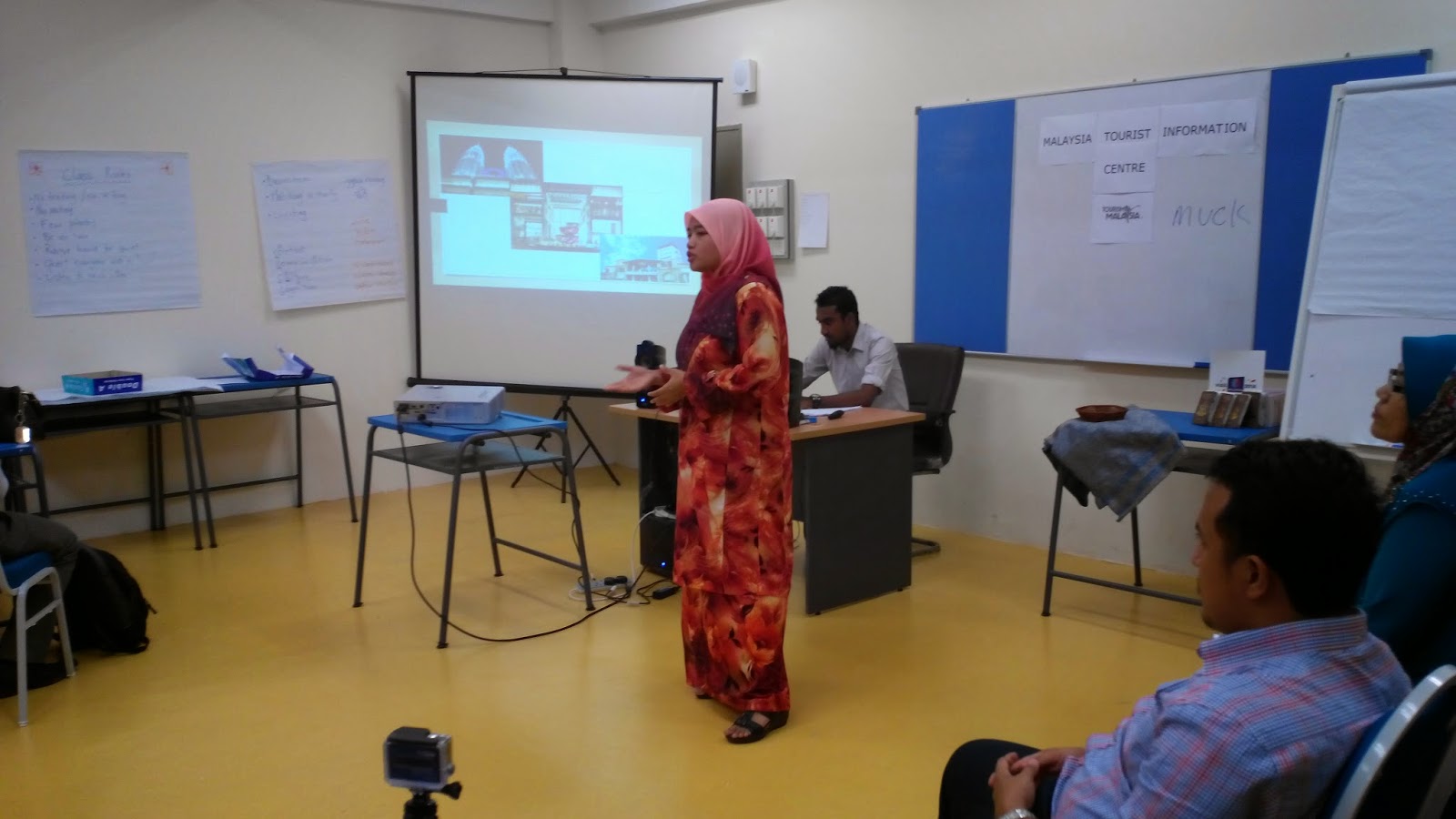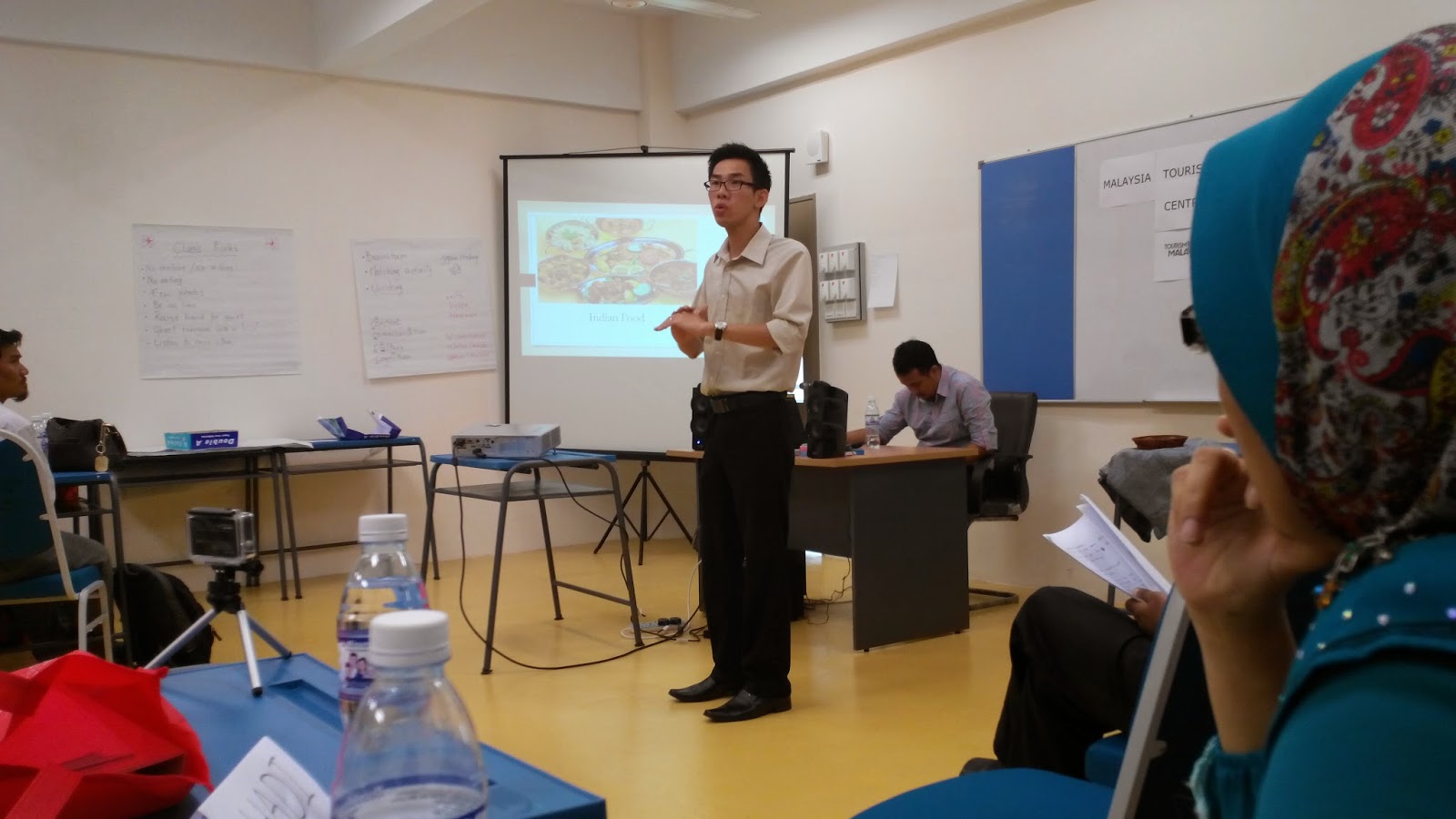Day
8 Session 3 (Friday, 17 Oct. 2014, 3 – 4.30pm)
Friday's Presentation
Presentation is not really a difficult task, if you consider that it is just a manner in which you inform someone particular information. People do this all the time – when they are trying to communicate to one another. Basically, you have this idea in your head and you deliver the message to the person who is listening, like you would do when you talk to someone. However, a proper presentation is more than just that. When giving presentation, one of the many concerns that we have is to engage the audience into our topic. In order to accomplish this we have to consider a lot of things; the topic, our body language, the intonation, the message, the delivery and the list goes on. The presentation could turn out as a disaster or a pleasant experience for both the presenter and the audience and it depends on how the presenters prepare their presentation.
 Today I witnessed a case in which a presentation is
done right. Our class welcomes the second group to present their topic on
Malaysia. The very first thing I noticed is that the atmosphere was very
authentic, where I felt as if we were really tourists who were welcomed to
Malaysia. In order to make a presentation on a particular topic the presenter
must have an interest and a great knowledge of that topic. I didn’t think this
was a problem with the presentation as we were allowed to make the presentation
on any topic we wished so everyone could pick a topic that he or she is very
interested in and had a good knowledge of. It is then crucial that more research
must go into the topic if the presenter is not so familiar with it. Such is the
case in this presentation.
Today I witnessed a case in which a presentation is
done right. Our class welcomes the second group to present their topic on
Malaysia. The very first thing I noticed is that the atmosphere was very
authentic, where I felt as if we were really tourists who were welcomed to
Malaysia. In order to make a presentation on a particular topic the presenter
must have an interest and a great knowledge of that topic. I didn’t think this
was a problem with the presentation as we were allowed to make the presentation
on any topic we wished so everyone could pick a topic that he or she is very
interested in and had a good knowledge of. It is then crucial that more research
must go into the topic if the presenter is not so familiar with it. Such is the
case in this presentation.
The delivery of the presentation is crucial for its
success. All of the presenters had a good and clear projection of voice. They
also used good hand gestures in conjunction with verbal indicators to signal
transitions in the presentation. All these are very much appreciated and it
makes the presentation much easier to follow through. Some of the presenters
also display genuine interest in their presentation. People can perfect their
pace and tone. Even humor can be practiced and learned but a genuine
fascination in what you’re saying is very hard to fake. That is one of the key
strength of the second group’s presentation.
 I also liked the slides, as I felt that its simple
layout was easy on the eyes and yet, it still managed to be visually
attractive. The visual and animation was really pleasing to the eyes – not just
loads of writings. If visual aid is going to be used for the presentation, like
a power point presentation a lot of work has to go into developing and making
sure that the visual aid isn’t the whole presentation. Here I can see that such
was not a problem since everyone did not just purely presenting by reading on
the slides. It is also important that if visual aid is going to be used we make
sure that it will work at the time of the presentation. The last presenter did
have difficulty with the slides as hers were missing. However, the situation
was resolved after a few minutes.
I also liked the slides, as I felt that its simple
layout was easy on the eyes and yet, it still managed to be visually
attractive. The visual and animation was really pleasing to the eyes – not just
loads of writings. If visual aid is going to be used for the presentation, like
a power point presentation a lot of work has to go into developing and making
sure that the visual aid isn’t the whole presentation. Here I can see that such
was not a problem since everyone did not just purely presenting by reading on
the slides. It is also important that if visual aid is going to be used we make
sure that it will work at the time of the presentation. The last presenter did
have difficulty with the slides as hers were missing. However, the situation
was resolved after a few minutes.
Nervousness is a major problem for many people
during public speaking. Katie mentioned that good presenters should move
around, make eye contacts and use natural gestures for an effective delivery of
the presentation content. Although throughout the presentation, everyone spoke fluently
in general, there were a few times when the presenters stumbled over their
words and when they had to pause longer than they should to recall the points. However,
such moments were rare. Thus, I felt it did not seriously compromise the
effectiveness of the presentation.
Muhd Syafiq Ashraf bin Alno’man
Seberang Jaya Community College












































